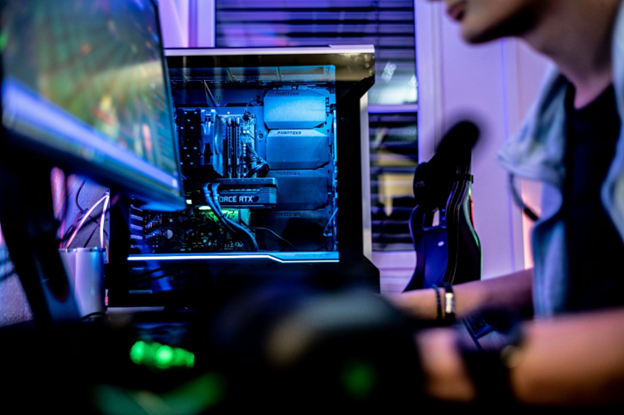The United States entertainment landscape is rapidly reshaping due to the sudden rise of eSports, which has attracted millions of fans and users from the U.S., positively affecting the industry. This article delves into the rapid growth of eSports, particularly in the U.S., exploring how this once niche hobby for gaming enthusiasts has now become a mainstream entertainment industry, rivaling traditional sports in popularity and media coverage.
By implementing massive tournaments with prizes in the millions and team sponsorships by major brands, eSports have evolved into more than just a passing trend – it’s a phenomenon that’s taking over the digital world.
The Early Days of eSports
Since the competitive gaming events started in the 1980s and 1990s, eSports has been right behind, following the growing trend. Space Invaders and Street Fighter were some of the first games in the industry that attracted dedicated followers, providing arcade tournaments and drawing audiences eager to see their favorite players compete. The first-ever eSports event was held by the Cyberathlete Professional League (CPL) in 1997 which became a forerunner for the industry. Even though viewership was strictly limited to small audiences, the concept of organized video games had already been established.
Moving on to the early 2000s, major popularity among the US audience was gathered by games like StarCraft and Counter-Strike, where the industry began to further develop, but grew even more popular with the launch of major games like League of Legends or Data 2 that additionally captured public’s attention. These games came with organized tournaments with large prize pools, attracting a large audience and users and showcasing the skill and strategy required for playing at the highest level.
Catalysts for Growth
Several factors have positively reflected on the rapid growth of eSports:
- Technological Advancements
The evolution of high-speed internet and the rise of powerful gaming hardware were groundbreaking points that allowed players to compete from anywhere in the world. Easy and quick access helped eSports gain popularity due to its high-quality online resources.
- Streaming Platforms
Twitch is a platform that additionally gathered more audience since launching in 2011. This platform allowed players to stream their matches in real-time and made it available for a global audience to enjoy. Following Twitch’s footsteps, YouTube became an essential sharing platform for reaching and engaging fans from anywhere from around the globe.
- Social Media and Community Building
Social Media platforms like Facebook, Instagram, and Twitter boosted the growth of eSports since players were able to share their thoughts, discuss strategies, and further immerse themselves in the gaming world thanks to these platforms.
The International (for Dota 2) and the League of Legends were the tournaments that gathered the most audience, setting high standards in the industry as these events gathered huge media coverage and sponsorships from the brands looking to join in on the eSports audience, additionally impacting its growth.
Cultural Acceptance and Mainstream Integration
Along with gaining huge popularity, eSports began to seamlessly blend with the US culture. Popular sports leagues and organizations like the NBA, NFL, and MLS recognized the eSports potential, proposing partnerships and collaborations. For example, the NBA launched its first game, the NBA 2K League, based on its popular basketball game. This collaboration allowed users to view eSports as a legitimate extension of the sports world, closing the gap between virtual and physical competition.
In addition, different media networks recognized the potential and started broadcasting eSport events. ESPN and TBS were the first to bring matches to audiences who may not have been exposed to gaming before. Furthermore, celebrities like Drake, Michael Jordan, and Will Smith started investing in eSports teams to elevate the sport’s status and bring in more audience. As the popularity grew, brands like Coca-Cola, Red Bull, and Intel began proposing sponsorship collaborations, mirroring the endorsements seen in traditional sports.
Economic Impact and Industry Growth
As the industry grew larger in popularity, so did the finances in this sector. The global eSports market in 2021 was valued at more than $1 billion, as the US contributed most to this revenue. Sponsorships, advertising, media rights, and viewership numbers keep increasing each year, leaving a positive effect on the industry.
Due to its huge popularity, eSports have developed jobs beyond just players and coaches, as an entire ecosystem needed to be created around the industry, hiring roles of commentators, content creators, marketers, analysts, and various event organizers. A commentator’s job is to elevate the experience of watching the game and immersing the audience deeper into the marrow of each gameplay, whereas content creators produce videos, articles, and podcasts that cover eSports news and strategies for the audience to become even more intrigued.
Following the rise of the industry, team franchises like Call of Duty and Overwatch also opened new revenue opportunities. These teams operated like traditional sports franchises thanks to the franchising fees, team merchandise, and in-game purchases that have created a sustainable business model in eSports.
Conclusion
eSports has proven its worth and established its position in the US. Thanks to all the growing audiences, investments, and major career opportunities, the future of eSports in the United States looks brighter than ever. Following all the technological advancements it is certain that this industry will continue to impact the American culture and the broader entertainment landscape, bringing closer fans and audiences as well as closing the bridge between traditional sports and gaming.
